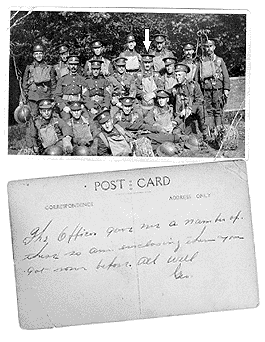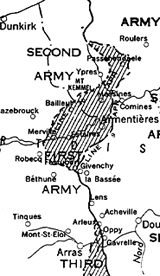near Vimy, France
27 Feb. 1918
The 4th C.M.R. was a battalion comprised of about a thousand men. Not counting administrative staff and non-combat personal, it represented 650 fighting men. It was one of three battalions in the 8th Canadian Brigade, a part of the 3rd Canadian Infantry Division in the Canada Corps.
Upon George's arrival, the weather was cold and wet, with spring arriving later in mid-March. A note from the battalion's chronicler upon returning to the familiar Merricourt sector read:
- "The wide No-Man's-Land still existed, but long grass and weeds blanketed
the devastation of a year ago, the rank vegetation covering the old shell
holes and rusted wire." (19)
George's Infantry Pin

March 1918
On one evening, while retiring at camp after a day supporting front line troops, the men watched as German reconnaissance destroyed some observer balloons:
- "The aerial activity was more noticeable and the monotony of the lengthening
evenings was broken by admiring the audacious airmen. One evening at tea-time
in the cramped quarters of the Cubitt Camp, just to the east of Neuville
St. Vaast, a football game was interrupted by the sudden appearance of
a Hun scout-machine dropping from a serene open sky. The "Archies" opened
on him, and the men tried to wing him with their rifles. He dived gracefully
at a captive-balloon buoyed over the camp. A rapid "pop","pop","pop" a
gushing "puff" and the balloon was in flames. He calmly soared and dived
in succession on one at Souchez and another at Ablain St. Nazaire repeating
the feat. He swiftly veered away and was out of sight before the gently-descending
black specks in the parachutes had floated to the ground." (20)
21 March 1918
The 4th was defending the line, replacing spent battalions as needed, and was George's first large-scale battle. By April 4, a second effort by the Germans at Amiens was held back. French reserves arrived at the northern British front, and the Germans moved yet further north and on April 9, attacked between Armentières and the canal of La Bassée.
12 April 1918

- "Nearly seven thousand people, without the help of their strong men
who were in the fighting-line elsewhere, were carrying bundles of bedding,
dishes, kitchen utensils and garden tools. Women pushed wheelbarrows, children
trundled baby carriages and many old men dragged a heavy two-wheeled cart
sometimes with the aid of a mangy cur." (21)
- "This was one of the notably British days in the war. And as in other
crises in former wars on land and sea there came down to the men from the
Commander-In-Chief, concise words, peculiarly British, telling them to
put their backs to the wall." (21)
- "Every position must be held to the last man: there must be no retirement.
With our backs to the wall and believing in the justice of our cause, each
one of us must fight on to the end." -- General Haig, British Commander
in France (22)